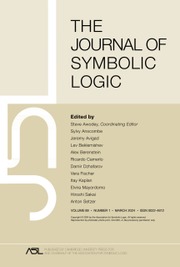Article contents
Relevance and paraconsistency—a new approach
Published online by Cambridge University Press: 12 March 2014
Extract
In this work we describe a new approach to the notions of relevance and paraconsistency. Unlike the works of Anderson and Belnap or da Costa (see [2], [8] and [7]) we shall mainly be guided in it by semantical intuitions. In the first two sections we introduce and investigate the algebraic structures that reflect those intuitions. The corresponding formal systems are briefly described in the third section (a more detailed treatment of these systems, including full proofs, will be given in another paper).
Our basic intuitive idea is that of “domains of discourse” or “relevance domains”. Classical logic, so we think, is valid in as much as sentences get values inside one domain; limitations on its use can be imposed only with respect to inferences in which more than one domain is involved. There are two basic binary relations over the collection of domains. One is relevance. It is reflexive and symmetric (but not necessarily transitive). Under a given interpretation two sentences are relevant to each other when their values are in relevant domains. Another basic relation between domains, no less important, is that of grading according to “degrees of reality”. The idea behind it is not new. Gentzen, for example, divided in [9] the world of mathematics into three grades, representing three “levels of reality”. The elementary theory of numbers has the highest degree or level of reality; set theory has the smallest degree and mathematical analysis occupies the intermediate level. In the theory of types, or in the accumulative von Neumann universe for set theory, we can find indication of a richer hierarchy.
Information
- Type
- Research Article
- Information
- Copyright
- Copyright © Association for Symbolic Logic 1990
References
REFERENCES
- 19
- Cited by

